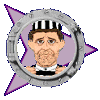Convicts were housed below decks on the prison deck and further confined behind bars. In many
cases they were restrained in chains and were only allowed on deck for fresh air and exercise.
Conditions were cramped and they slept on hammocks. Very little information seems to be
available about the layout of convict ships but a few books do contain artists impressions and
reproductions of images held in library collections.
Although the six convict ships, three supply ships and two naval ships of the first fleet
arrived with their cargo of 780-odd convicts in relatively good condition, the same cannot be
said for those that followed during the rest of the century.
Of the 1000-odd convicts sent on the second fleet, 260 or more died during the voyage. As
mentioned in the section on hulks, many were diseased when they embarked and those who managed
to survive the voyage were severely weakened by scurvy, dysentery and fever.
On subsequent voyages the story was not much different and the treatment of the convicts was a
disgrace. Private merchant ships were contracted to transport the convicts and their masters
looked for ways to improve their profit margins by withholding the convicts' rations, keeping
them chained below decks without fresh air and inflicting harsh and cruel punishment in an
attempt to maintain discipline. Although official complaints were made after the fact, justice
was never seen to be done. In one particular case, Thomas Dennott, the master of the
'Britannia', was described as a sadist. He brought a cargo of Irish convicts in 1797 and
subjected them to brutal discipline of 300, 400 and 800 lashes. The worst death rate, however,
was recorded on the Hillsborough which arrived in 1799. Typhoid killed 95 of her 300 convicts.
The English authorities began to review the system in 1801 and the general result was that ships
would be sent regularly twice a year at the end of May and the beginning of September to avaid
the dangerous southern hemisphere winter season. The surgeons employed by the early contractors
were answerable to the master of the ship who had the final say. They had been replaced by
independent Surgeon Superintendents who solely responsible for the well being of the convicts.
As time went on, successful procedures were developed and the surgeons were supplied with
explicit instructions as to how life on board was to be organised. Add that to the fact that a
bonus was paid to the charterers to land the prisoners safe and sound at the end of the voyage
and a different story began to emerge.
By the time the exiles were being transported in the 1840s and onwards, a more enlightened
routine was in place which even included the presence on board of a Religious Instructor to
educate the convicts and attend to their spiritual needs. The shipboard routines on some of the
Western Australian transports during the 1860s have been transcribed and are worth reading.
| 

